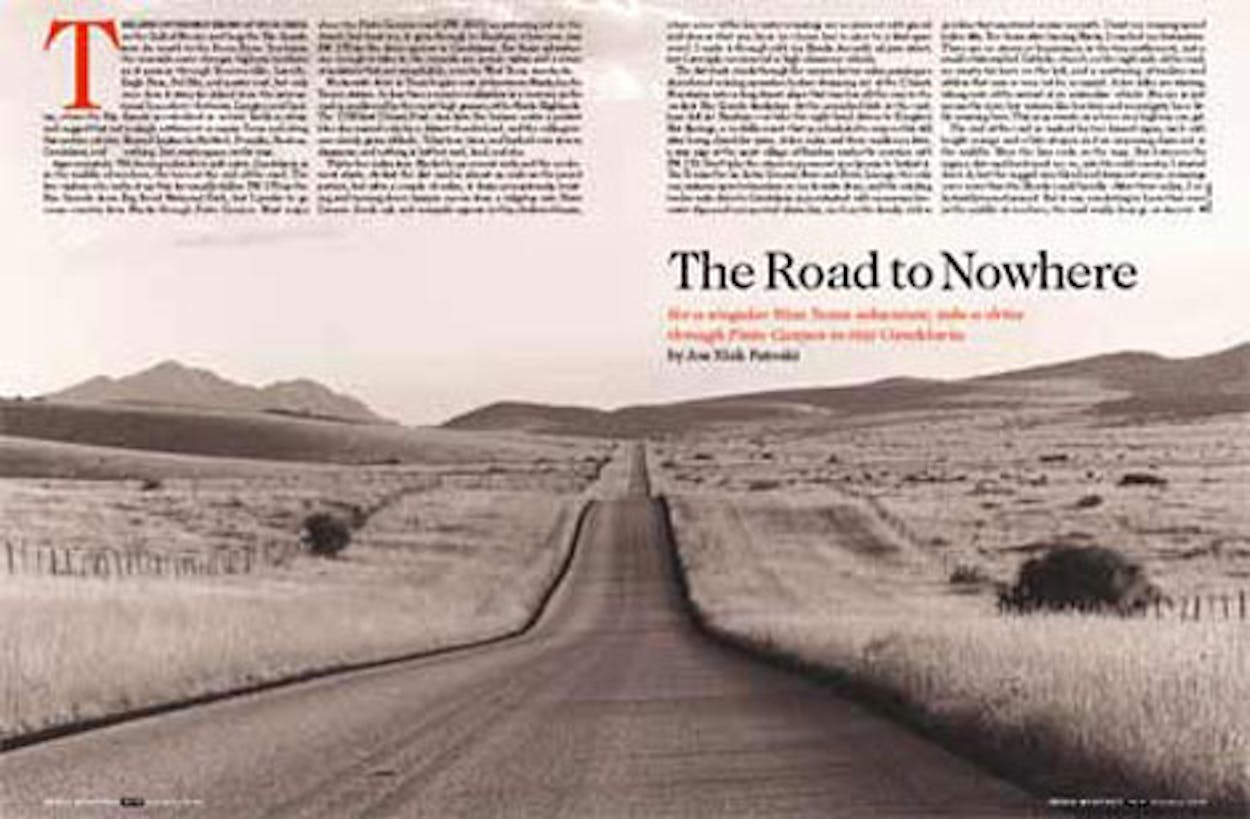THE LINE ON THE MAP BEGINS AT BOCA CHICA on the Gulf of Mexico and hugs the Rio Grande from its mouth to the Pecos River. Ten times the riverside route changes highway numbers as it passes through Brownsville, Laredo, Eagle Pass, Del Rio, and points west, but only once does it stray far inland from the international boundary—between Langtry and Lajitas, where the Rio Grande is entombed in canyon lands so steep and rugged that not a single settlement occupies Texas soil along this section of river. Beyond Lajitas lie Redford, Presidio, Ruidosa, Candelaria, and … nothing. Just empty space on the map.
Approximately 750 driving miles from salt water, Candelaria is in the middle of nowhere, the town at the end of the road. The few visitors who make it up this far usually follow FM 170 up the Rio Grande from Big Bend National Park, but I prefer to go cross-country from Marfa through Pinto Canyon. Most maps show the Pinto Canyon road (FM 2810) as petering out in the desert, but trust me, it goes through to Ruidosa, where you join FM 170 for the drive upriver to Candelaria. For those adventurous enough to take it, the rewards are scenic vistas and a sense of isolation that are remarkable, even by West Texas standards.
My favorite drive in Texas begins west of downtown Marfa, by the Texaco station. In less than a minute civilization is a memory as the road is swallowed by the waist-high grasses of the Marfa Highlands. The 7,730-foot Chinati Peak rises from the horizon under a perfect blue sky marred only by a distant thunderhead, and the rolling terrain slowly gains altitude. Telephone lines and barbed-wire fences disappear, and nothing is left but road, land, and sky.
Thirty-two miles from Marfa the pavement ends and the excitement starts. At first the dirt road is almost as wide as the paved portion, but after a couple of miles, it drops precipitously, twisting and turning down hairpin curves from a ridgetop into Pinto Canyon. Scrub oak and mesquite appear in this sheltered basin, where some of the low-water crossings are so jammed with gravel and stones that you have no choice but to slow to a first-gear crawl. I made it through with my Honda Accord’s oil pan intact, but I strongly recommend a high-clearance vehicle.
The dirt track winds through the canyon for ten miles, passing an abandoned mining operation before dropping out of the Chinati Mountains onto a long desert slope that reaches all the way to the verdant Rio Grande floodplain. At the unmarked fork in the road, bear left for Ruidosa—or take the right-hand detour to Kingston Hot Springs, a no-frills resort that is scheduled to reopen this fall after being closed for years. A few miles and three mailboxes later, a stop sign at the quiet village of Ruidosa marks the junction with FM 170. Don’t take the return to pavement as a license to hotfoot it. You’ll miss the La Junta General Store and Ben’s Lounge, the only way stations open to travelers on my favorite drive, and the winding twelve-mile drive to Candelaria is punctuated with numerous low-water dips and unexpected obstacles, such as the family of five javelina that sauntered across my path. I kept my cruising speed below fifty. Two hours after leaving Marfa, I reached my destination. There are no stores or businesses in the tiny settlement, just a small whitewashed Catholic church on the right side of the road, an empty tin barn on the left, and a scattering of trailers and adobes that may or may not be occupied. A few folks are stirring, taking note of the arrival of an unfamiliar vehicle. Mexico is just across the river, but notions like borders and sovereignty have little meaning here. This is as remote as a town on a highway can get.
The end of the road is marked by two hazard signs, each with bright orange and white stripes and an imposing diamond in the middle. Here the line ends on the map. But between the signs a dirt road beckoned me on, into the wild country. I started down it, but the rugged ranchland and frequent arroyo crossings were more than the Honda could handle. After three miles, I reluctantly turned around. But it was comforting to know that even in the middle of nowhere, the road really does go on forever.








